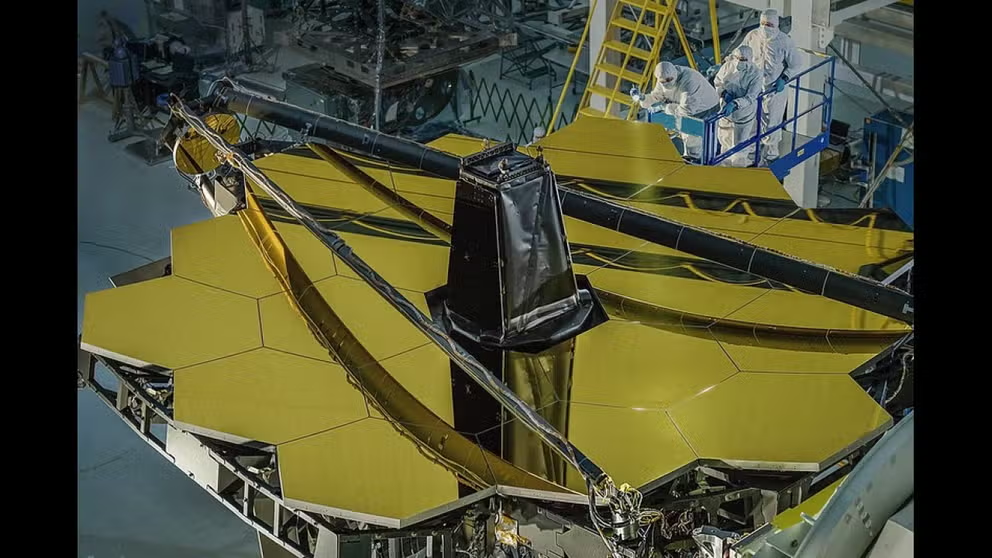James Webb: The most powerful space telescope by the numbers
The James Webb Space Telescope will study the first galaxies.
James Webb Space Telescope: By the numbers
James Webb Space Telescope, the most powerful space observatory ever built, is about to begin its mission.
The long-awaited launch of the James Webb Space Telescope is nearly over after decades of planning and international collaboration.
Webb is a partnership mission by NASA, the European Space Agency and the Canadian Space Agency. With a mission as complex as Webb, there are many moving pieces to make it happen. Here's a look at the James Webb Space Telescope by the numbers.
7:20 a.m. ET
The massive, powerful telescope is scheduled to liftoff on Dec. 25 at 7:20 a.m. ET, beginning its journey to find answers to the most puzzling questions about the cosmos, including how our solar system formed. Webb is launching on an Ariane 5 rocket from French Guiana at Europe's Spaceport.
The launch was delayed from Dec. 22 to Dec. 24 and then again to Christmas morning due to weather.
13.5 billion years
Webb is designed to use ultraviolet and visible light to see back to the birth of stars and when the first galaxies formed 13.5 billion years ago. This is a few hundred million years after the big bang.
21 feet
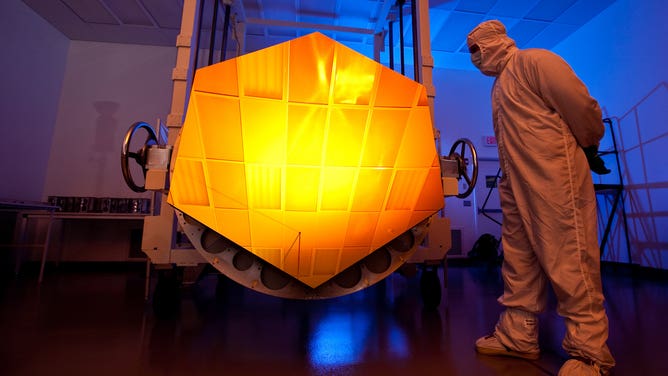
This is a photo of one of the James Webb Space Telescope's primary mirror segments coated with gold by Quantum Coating Incorporated. It's NOT a flight segment, it's the engineering design unit. The photo was taken at BATC by Drew Noel.
(Drew Noel/NASA)
Webb has one 21-foot-long primary mirror comprised of 18 gold-plated hexagonal mirrors that make up the honeycomb shape the telescope is known for. The telescope also has a circular secondary mirror about .74 meters in diameter. The mission will mark the largest mirror ever in space.
5 layers
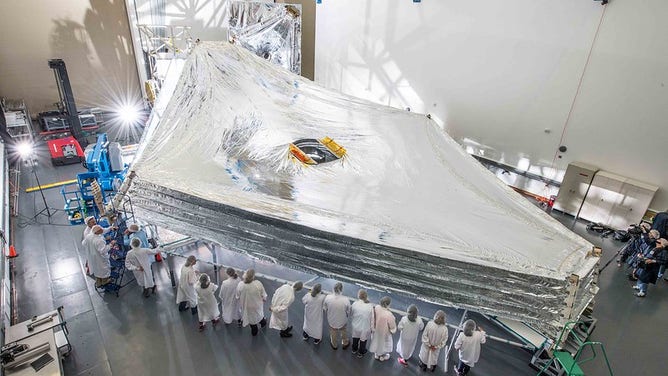
Webb's Sunshield test unit stacked and expanded at a cleanroom in the Northrop Grumman facility in Redondo Beach, California. (Image: NASA/Chris Gunn)
Webb’s sunshield is made up of five layers and spans the size of a tennis court. After launch, the sunshield will unfold, protecting Webb's science instruments from the sun’s heat. The sunshield is about 69.5 feet long and 46.5 feet wide at its full expansion.
NASA describes the sunshield as JWST's sunscreen with an SPF of 1 million.
4 science instruments
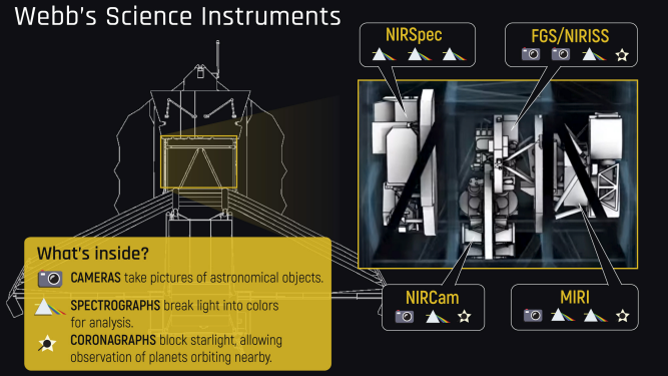
A NASA graphic explains the James Webb Space Telescope instruments.
(NASA)
To gaze back to the oldest galaxies, Webb had four scientific instruments a near-infrared camera known as NIRCam, Near-Infrared Spectrograph or NIRSpec, Mid-Infrared Instrument or MIRI and the Near-Infrared Imager and Slitless Spectrograph (NIRISS) with the Fine Guidance Sensor (FGS).
Combined, the instruments will help scientists uncover the solar system's secrets. For example, NIRCam will detect distant objects like the first generation of stars to form. MIRI will dig deeper to confirm what cosmic objects are by seeing elements such as water or methane.
Because Webb is designed to look at infrared light emitted from cosmic objects, its instruments must be extremely cold, operating at -388 degrees, to prevent Webb from detecting its own heat emissions. Webb's camera or MIRI will be even colder at -448 degrees.
18 feet
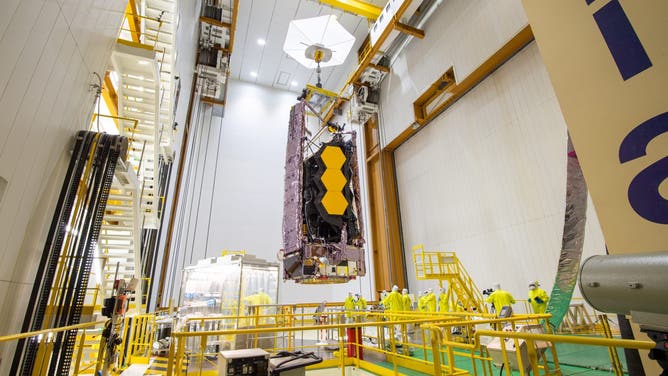
The James Webb Space Telescope is lifted up inside the cleanroom to be placed on top of the rocket. (Image credit: ESA-M.Pedoussaut)
(ESA)
Webb's ride to space is the Ariane 5 rocket. The observatory must fold up like origami to fit inside the rocket's 18-foot wide and 56-foot tall nose cone. Webb is over 21 feet in diameter and takes up about 270 feet with its sunshield. To fit inside the rocket's nosecone, Webb's 18 gold mirrors are segmented on a hinged structure, allowing it to fold up for launch.
It will take about two weeks for Webb to unfold in space.
44 countries
The most powerful telescope ever built could only happen through international cooperation. NASA teamed up with Canada and Europe to develop and launch the James Webb Space Telescope. The observatory has been under development since even before its predecessor, the Hubble Space Telescope, launched.
However, the mission’s international roots go even further. Scientists from all over the world have submitted proposals to use Webb for their research.
Scientists from 44 countries were chosen to use the infrared telescope to study unknown worlds unknown and make discoveries that will potentially change what we know about the universe.
The first year of Webb’s science operations has already been decided, but the observatory has many more years of observations ahead. It could operate for up to ten years.
"There are many exciting programs in the first year that addresses questions that we didn’t even know we had until a few years ago," said JWST project scientist Klaus Pontoppidan during a media briefing in spring 2021.
1 million miles
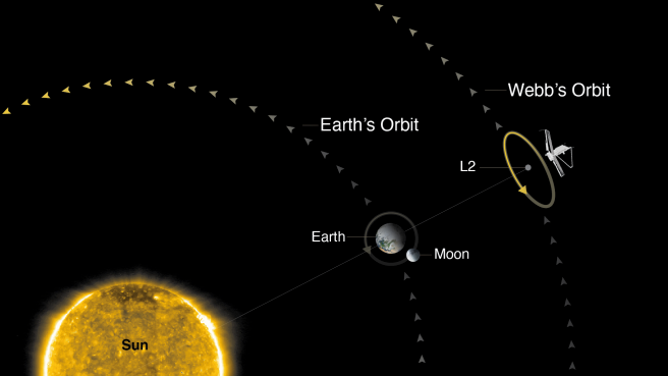
Webb will operate at the second Lagrange point in space. (Image: NASA)
After launch, Webb will travel 1 million miles from Earth before it can begin its science mission.
This sun orbit is known as the second Lagrange point or L2. Scientists chose this orbit specifically because the gravitational pull of the sun and Earth will reduce the need for as much fuel for the spacecraft. It's also a good spot for communication via the Deep Space Network, which NASA and its international partners use to download data.
It will take one month for Webb to reach the second Lagrange point.
